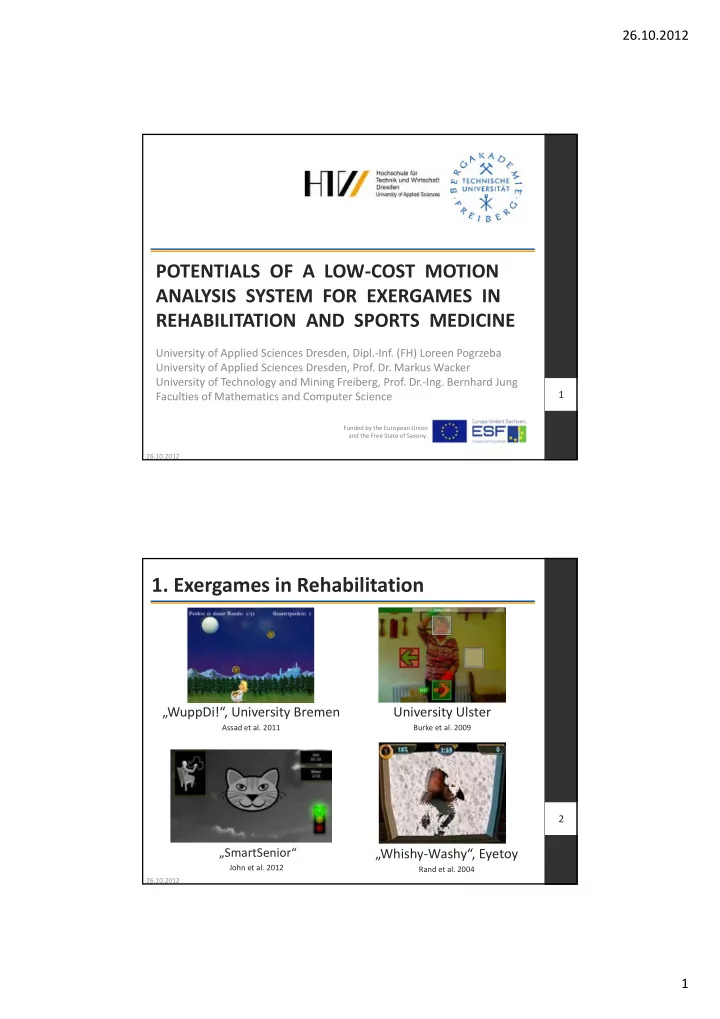

26.10.2012 POTENTIALS OF A LOW ‐ COST MOTION ANALYSIS SYSTEM FOR EXERGAMES IN REHABILITATION AND SPORTS MEDICINE University of Applied Sciences Dresden, Dipl. ‐ Inf. (FH) Loreen Pogrzeba University of Applied Sciences Dresden, Prof. Dr. Markus Wacker University of Technology and Mining Freiberg, Prof. Dr. ‐ Ing. Bernhard Jung 1 Faculties of Mathematics and Computer Science Funded by the European Union and the Free State of Saxony. 26.10.2012 1. Exergames in Rehabilitation „WuppDi!“, University Bremen University Ulster Assad et al. 2011 Burke et al. 2009 2 „SmartSenior“ „Whishy ‐ Washy“, Eyetoy John et al. 2012 Rand et al. 2004 26.10.2012 1
26.10.2012 2. Motivation • Motion analysis can be an effective method to diagnose and document the therapeutic progress of patients • If used, often does not fulfill requirements of therapists Annema et al. 2010 Motion analysis system (MAS) which: – is truly helpful for therapists 3 – could be combined with various exergames 26.10.2012 Potentials of a Low ‐ Cost Motion Analysis System for Exergames in Rehabilitation and Sports Medicine 3. PARTICIPANTS AND PARTNERS 4 26.10.2012 2
26.10.2012 3.1. Rehabilitation: Swedish Music Therapy 5 Recording of entire sessions of about 25 min. in length Collaboration with Swedish therapists of function ‐ oriented music therapy (FMT) 26.10.2012 After Before 3.2. Rehabilitation: Vojta Therapy 6 Recording of controll motion before and after treatment Collaboration with therapists of International Vojta Society 26.10.2012 3
26.10.2012 3.3. Sports Medicine: Gait Analysis 7 Collaboration with University Hospital Carl Gustav Carus Dresden at the clinic and polyclinic for orthopedy 26.10.2012 3.4. Sports Medicine: Jump Height 8 Collaboration with training theorists of the Olympic Training Center Dresden/Chemnitz 26.10.2012 4
26.10.2012 ? Hardware: • Hardware : • o Short preparation time o Short preparation time o Not distracting o Contact ‐ free technology (no suits, no marker) o Input technology for patients with various special needs o No calibration pose o Portable and robust o Low ‐ priced Software: • User ‐ friendly interface • control over choice/form of • displayed data, store/load ‐ 9 functionality Annema et al. 2010 3.5. Needs of Therapists and Patients 26.10.2012 Potentials of a Low ‐ Cost Motion Analysis System for Exergames in Rehabilitation and Sports Medicine 4. SETUP 10 26.10.2012 5
26.10.2012 4.1. Components of our MAS 11 Hardware: Microsoft Kinect Sensor Software: In ‐ house developed software modules 26.10.2012 4.2. Setup 12 Fixed position of Kinect at FMT treatment room 26.10.2012 6
26.10.2012 4.3. Demonstration: Recorder 13 Realtime recording of video image, sound and skeletal data while patient is performing the exercises 26.10.2012 Hans 4.4. Demonstration: Analyzer 14 Replaying or scrolling through the video and motion streams with time sliders, adding comments, displaying motion trajectories and changing the displayed motion graphs 26.10.2012 7
26.10.2012 Potentials of a Low ‐ Cost Motion Analysis System for Exergames in Rehabilitation and Sports Medicine 5. RESULTS AND DISCUSSION 15 26.10.2012 5.1. Results • Recording speed, accuracy, and stability were completely satisfactory for tested applications • Easy detection of irregular or asymmetric motion • Our MAS enabled therapists for the 1st time to: – Capture the motion of their patients Objectively evaluate the therapeutic progress 16 26.10.2012 8
26.10.2012 Left Hand | Left Hand | Right Hand Right Hand 5.1. Results: Asymmetric arm motion in FMT 17 Spatially or temporally asymmetrical motion points to restricted range of motion or compensatory motion 26.10.2012 5.2. Discussion • Limitations of our MAS: – Not suited for outdoor activities – Max. sample rate of 30 fps – Limited field of view (masking problems) – No information about muscular strength or activity – Not as precise as markerbased/markerless MAS • MAS is well suited for analysis of stationary motion non ‐ stationary sports require 18 longer testing period 26.10.2012 Berührungslose Bewegungsaufnahme 9
26.10.2012 6. Prospects • Long ‐ term studies • Automatic detection of motion patterns Identify relevant patterns which were not (yet) recognized by therapists • Independent use of MAS by all partners Continuous improvement Kinect 2.0 with better functionalities 19 26.10.2012 Questions? 20 Dipl. ‐ Inf. (FH) Loreen Pogrzeba | pogrzeba@htw ‐ dresden.de | www.drematrix.de Prof. Dr. Markus Wacker | wacker@informatik.htw ‐ dresden.de | www.drematrix.de Prof. Dr. ‐ Ing. habil. Bernhard Jung | jung@informatik.tu ‐ freiberg.de | http://www.informatik.tu ‐ freiberg.de 10
26.10.2012 References Assad, O., Hermann, R., Lilla, D., Mellies, B., Meyer, R., Shevach, L., Siegel, S., Springer, M., Tiemkeo, • S., Voges, J., Wieferich, J., Herrlich, M., Krause, M. and Malaka, R. (2011). WuppDi! ‐ Supporting Physiotherapy of Parkinson's Disease Patients via Motion ‐ based Gaming. In: Proc. Mensch und Computer 2011 (Entertainment Interfaces), pp. 469 ‐ 478 Burke, J.W., McNeill, M.D.J., Charles, D.K., Morrow, P.J., Crosbie, J.H. and McDonough, S.M. (2009). • Optimising Engagement for Stroke Rehabilitation using Serious Games. J. In: The Visual Computer 25(12), pp. 1085 ‐ 1099 John, M., Klose, S., Kock, G., Jendreck, M., Feichtinger, R., Hennig, B., Reithinger, N., Kiselev, J., • Gövercin, M., Steinhagen ‐ Thiessen, E., Kausch, S., Polak, M. and Irmscher, B. (2012). SmartSenior’s Interactive Trainer ‐ Development of an Interactive System for a Home ‐ Based Fall ‐ Prevention Training for Elderly People. In: Proc. Ambient Assisted Living – Advanced Technologies and Societal Change, pp. 305–316 Rand, D., Kizony, R. and Weiss, P.L. (2004). Virtual reality rehabilitation for all: Vivid GX versus Sony • PlayStation II EyeToy. In: Proc. 5th Intl. Conf. on Disability, VR & Assoc. Tech. 2004, pp. 87–94 Annema, J. ‐ H., Verstraete, M., Abeele, V.V., Desmet, S., and Geerts, D. (2010). Videogames in • Therapy: A Therapist’s Perspective. In: Proc. of the 3rd Intl. Conf. on Fun and Games, pp. 94–98 21 26.10.2012 11
Recommend
More recommend